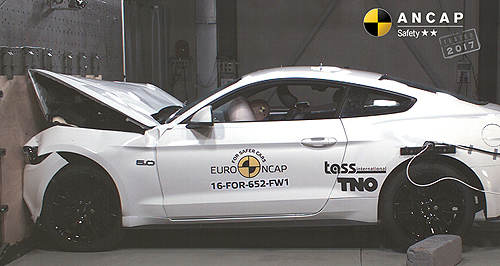Make / Model Search
News - General News - SafetyANCAP gears up for 2018Crash magnet: ANCAP will reintroduce the full-width frontal crash test to its testing regimen for the first time since 2002. Local crash body to introduce tougher new crash tests to line up with Euro NCAP30 Aug 2017 By TIM ROBSON AUSTRALIA’S independent automotive crash-testing body, the Australasian New Car Assessment Program (ANCAP), is gearing up to introduce tougher standards for locally sold vehicles from January 1 next year. ANCAP will align itself even more closely with Euro NCAP testing protocols and scoring regimens from next year, in a continuation of the program started in 2015. A focus on pedestrian safety as well as a requirement for more lane support systems (LSS) across a vehicle’s entire line-up will be joined by the return of the full-width frontal crash test and a revision of the side-impact pole test. ANCAP chief executive James Goodwin told GoAuto that the 2018 changes were an integral part of keeping pace with vehicle safety in the market, and constituted major changes to the rating and assessment program. “2018 is a milestone year,” said Mr Goodwin. “We want to continually push the boundaries of keeping people on their toes. There’ll be changes to existing tests, and from 2018 we’ll be reintroducing full-width frontal test. “With the side-impact test, we’ll be using a heavier test rig to acknowledge that vehicles are getting heavier. So, therefore, we need to change the test rig to suit what’s happening in the real world.” The pole test will now consist of an oblique pole test, where the vehicle on test will approach at an angle and at a higher speed of 32km/h (up from 29km/h). The full-width frontal impact test, where the vehicle is crashed directly into a barrier, is conducted at 50km/h, while the frontal offset test will stay at 64km/h. Vehicles are crashed with a full load of water in place of fuel, 57kg test dummies in the driver’s seat and left rear seat, and 36kg of simulated baggage in the luggage compartment.  Left: ANCAP chief executive James Goodwin Left: ANCAP chief executive James GoodwinAs well, ANCAP will – for the first time – conduct an assessment for rear seat occupant protection, based on data from the crash tests and examination of devices such as seatbelt pretensioners. A whiplash test protocol will also be used to measure the effectiveness of second- and third-row seatbelts and restraints, which may expose weaknesses particularly in centrally mounted restraints. “We call it child occupant protection, but it also could be described as rear seat occupant protection,” Mr Goodwin said. “We want to make sure that some of the safety systems that have been helping to keep the driver and the front passenger safe are now being deployed in the rear seat as well.” Scoring for driver-assist systems will also be changed, with higher scores given to vehicles that incorporate safety technology like autonomous emergency braking (AEB) and LSS. “What they (a manufacturer) have done in autonomous emergency braking, blind-spot monitoring, lane-keep assistance and so on, they will be scored higher than what they’ve done in the past,” Mr Goodwin explained. In the case of vehicles that do not offer driver aids across an entire line-up – for example, the base Subaru Impreza and XV, as well as the entry-level Hyundai i30 – Mr Goodwin said that ANCAP has the authority to issue a dual rating for a particular car, but it would prefer not to go down that path. “What we’re hoping with the new rating is we won’t see those difference between variants, but what we might see from next year is if vehicle brands don’t step up and start offering that technology across the board, then consumers might start seeing more dual ratings for the same model where you might see that,” he said. “Australia last really saw that in the early-to-mid-2000s when curtain airbags were optional, and that was probably the last time that Australians have been accustomed to dual ANCAP ratings for the same model. We’ve actually always had the option to do it. It’s just that it's not really presented itself that often.” Mr Goodwin suggested that it was in the best interests of a car-maker to offer all its safety features across a given model line-up. “When you’ve designed that technology for a car, why not offer it across the range?” he said. “That’s really what we want. We want the safest vehicles on the road and safety really shouldn’t be lumped in with some of those other luxury features. “Why do you have to get leather seats before you can get AEB on some models? Why do you have to order the model with the bigger engine or the alloy wheels before you get blind-spot monitoring and lane-keeping assistance? We want to ensure that the safety specifications, that should be across the range. Keep the luxury features for those different trim levels.” The costs to ANCAP, which is funded by state and federal governments as well as state-based motoring bodies, will increase, owing to the more stringent testing regime. “Obviously an additional physical test comes into the cost so that is one extra car that needs to be written off during the process,” said Mr Goodwin. “We’ve also got the test costs involved of testing the effectiveness of autonomous emergency braking which takes time, takes a test track and so on, so there is going to be additional costs for the rating.” Mr Goodwin said he believed, however, the additional costs were a worthwhile investment. “All ANCAP testing is expensive, but it is an investment of time and energy to get a safer product into the marketplace,” he said. “Really, the vehicle brands appreciate it because they are the ones who know that they will have the competitive advantage in the marketplace if they have got the best offering.”  Read more11th of August 2017  ANZAC push for global safety standardsANCAP, Mercedes-Benz address FIA conference to push for standardised safety27th of July 2017  ANCAP: Only three stars for LDV G10LDV G10 van and people-mover awarded just three stars from ANCAP |
Click to shareGeneral News articlesResearch General News Motor industry news |











Facebook Twitter Instagram